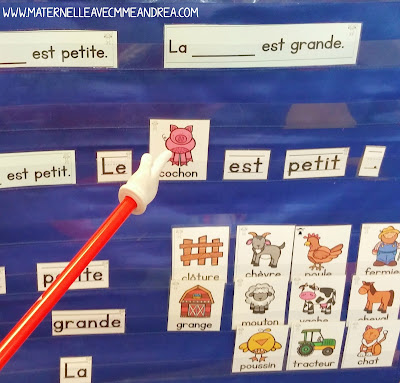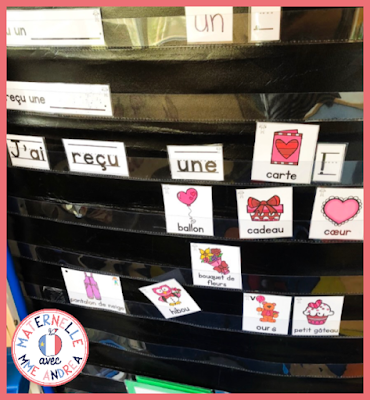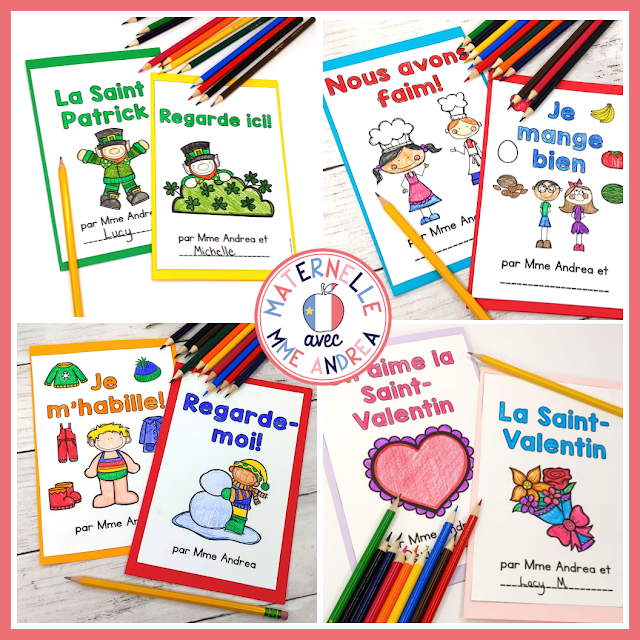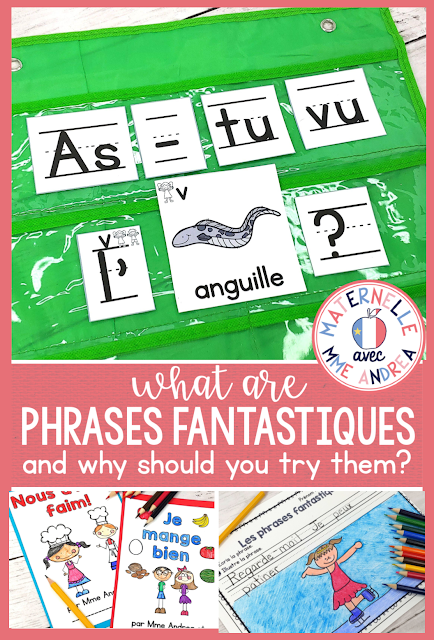One of the trickiest things to teach in maternelle can definitely be writing.
Many of our students can’t even speak French yet, but we are expected to teach them the mechanics of writing… PLUS how to write stories that have great content (for their age, of course!).
When I first started teaching writing, I tried to teach all of the above all at the same time – how to come up with a great idea and write about it, PLUS how to make sure you are writing as you should, with proper punctuation, upper/lowercase letters, spaces, sentence structure, etc.
It was a lot for my students!
While I do still cover many mechanics of writing during my writer’s workshop-style lessons, I have found it beneficial to separate content from mechanics a bit, and take some extra time to teach + practice writing mechanics over and over in a more structured situation with my students, while providing them with a predictable framework for the content.
And, in combination with time every day to allow my students to write stories of their own choosing, it’s made a HUGE difference in my students’ writing!
How do I do this?
Via my Phrases fantastiques pocket chart sentences!
Not sure what I’m talking about? Read on for more info.
First of all, let me just say that I am SO EXCITED to finally be blogging more about my Phrases fantastiques resources!
These are one of my favourite resources I’ve ever made, and have made a big difference for my students.
My students aren’t usually really ready for this activity until around December each year. And, if your students still aren’t quite ready at this point in the year, it’s all good! You can get some info from this blog post now, and start implementing Phrases fantastiques when your students are ready.
What are Phrases fantastiques?
Les phrases fantastiques are pocket chart sentences.
I have only ever used them in pocket charts, and that’s what I originally made them for, but as always, you can be creative and find other ways to use them if you don’t have a pocket chart.
{Here is an affiliate link to the pocket chart I use. It’s more expensive than some others, but it has lasted me 5 years and counting, when my previous one only lasted two years. It’s robust! And here is a link to the tutorial for the pocket chart stand my husband made me for my birthday last year. It’s less robust, but does the trick!}
If you absolutely don’t want a pocket chart or have space for one, you could definitely pop magnets on the backs of the pieces and use them on your whiteboard or any kind of magnetic board.
With Phrases fantastiques, your students will be building sentences using a model.
They are a great way for you to practice a TON of writing skills all at once, which I’ll go over a bit later in this blog post, but it’s not a replacement for having your students write creative stories from their hearts, about topics of their choosing :)
In each Phrases fantastiques set, you’ll find model sentences, all of the sight words needed to build the model sentences, vocabulary cards for finishing the model sentences, recording sheets, and two mini books for extended practice of the model sentences.
Here is an example from the winter set of some of the things included:
Each set has quite a few model sentences, to allow you to choose what your students need to work on.
I usually don’t do all of the included ones – my students would probably get pretty confused, especially at first! I just pick sentences that represent what we are able to do.
So, for example, for the Christmas set, we started with « J’aime le _____ ».
To start, I just put out the words that are masculin since it’s our first time – we had to learn all about that.
The second week, I added the « J’aime la ______. » and then « J’aime les _______. ».
That was it for our first go – I didn’t touch the other model sentences. If you’re in an older grade or your students are more ready, though, feel free to work on a variety of model sentences.
I slide the model sentences we are working on into the top rows of the pocket chart. I leave space to build our sentence, and then put all the vocabulary cards and sight words together near the bottom of the chart.
If there are a lot of vocabulary words, I might put the sight words all at the top as well.
Here’s a couple pictures from previous years to illustrate what I mean (the black pocket chart is the one I use now):
Each set also has a recording sheet. I’ll talk about how we complete that in next week’s blog post about our routine, but here’s an example:
Finally, there are the mini-books. The mini-books each target a target sentence in the pack. There are two mini-books in each set, but more than two model sentences, so not all sentences will be in the books.
I don’t usually use these for all of my students, but I do use them as guided reading books for some of my students. I talked all about how I do that in *this blog post*.
That about sums up all the parts that make up these resources. Next, I’ll talk more about all the different things you can teach and practice with your students using this resource
What Will Your Students Learn?
The biggest reason I LOVE Phrases fantastiques is that they teach our students SO. MANY. THINGS all at once!
Here’s a list of all the concepts and skills I could think of that our students are exposed to during a single Phrase fantastiques lesson:
- Reading and writing a variety of sight words – each week, we are learning new sight words and/or reviewing sight words that we learned in previous weeks. We are practicing both reading AND writing them in context
- Starting a sentence with a capital letter – I go over this explicitly with my students EVERY time. It starts to sink in for most of them eventually!
- Putting spaces between words – again, we talk about this EVERY single time!
- According masculin/féminin (SO HARD at this age!) – matching the little picture symbols in the corners of words like le/la/un/une/les with the symbols on the vocabulary cards has been the most effective way for me to teach this concept to my students so far. It’s soooo tricky for them, especially since we don’t really do this in English. Even if they don’t make the transfer yet to their own writing/speaking, at least they have been exposed to it, they know it’s a thing, and they begin to remember which articles go with which symbol!
- A TON of new vocabulary words – each month has as many vocabulary words as I could possibly think of! My students love learning them, and always amaze me. The easiest way to get them to learn them is to tell them I’m going to trick them haha – works every time!
- Punctuation at the end of a sentence – again, something we talk about every time. We choose between a period, an exclamation mark, or a question mark. There are also sometimes other punctuation marks as well, like dashes or hyphens.
- Directionality – reading & writing from left to right – each day when we build and when we read our sentences, we are reinforcing this skill
- Proper letter formation – we write our sentences TOGETHER, one letter at a time. We start at the top and go left to write, and talk about letters that are tall/short/have tails. We are writing these letters and words in context, one at a time, and my students know that if they focus and listen to my instructions, they will be able to write neater letters, more efficiently
- Le retour à la ligne suivante – where to go when they reach the end of a line and need to start writing on the next line – another big challenge at this age, but when you practice it just about every other day, it starts to sink in!
- Drawing a picture that matches what they write about – I have some students every year who really struggle with this – they don’t yet understand that the writing on the page has to make sense with the picture. This activity can help – I will ask things like “so we wrote about Père Noël here. Am I going to draw a kitten in my picture?”, and they begin to understand more and more about the link between what is written down and what we see/read
- 1:1 correspondence – each word being on its own, with clear spaces in between, helps with this. We read with a « bâton magique », and I require my students who come up to read to try again if they end up finishing reading but still having words left, or vice versa
- Correct sentence structure, en français. I love using these sentences to practice things like saying « J’aime » instead of « je j’aime » or « je aime », « je suis allé », « j’ai » instead of « j’ai a », etc. It helps!!
- And probably even more things that I’m forgetting, haha!
At first, our phrases fantastiques routine takes us awhile – up to 30 minutes, sometimes. But, once we get more used to it, we can get it done in just 10-15 mins. That’s a LOT of skills to be practicing in under 15 mins!
I will go over our whole routine in greater detail in my very next blog post, but I will take a second right now to note that we do these at the tapis all together – I am teaching and modeling explicitly all of the skills I shared above.
I think that this causes my students to get the biggest bang for their buck – they are going to get the most benefit from doing this activity with me there to guide them and make sure I’m pointing all of these important skills that they are learning out to them.
This will help them make the transfer to other subjects and activities throughout the day.
Hopefully, I’ve convinced you to give these a go if you haven’t already! Next week, I will explain exactly what our routine looks like, start to finish!
If you’re interested in using Phrases fantastiques in your classroom, you can check out the bundle with all the themes on TPT by clicking RIGHT HERE.
The themes are also all available for purchase individually, too – just click on any theme in the bundle for a closer look!
Looking for more writing tips? Fill out your name & email in the box below, and I’ll email you my FREE guide to writer’s workshop for French primary teachers!








